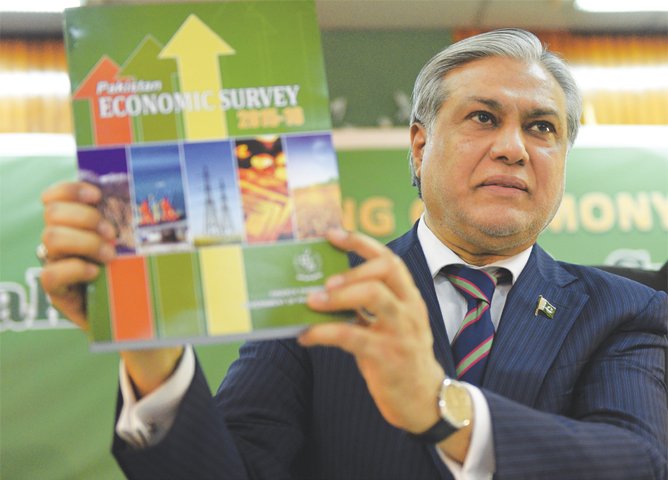
No matter how well or poor the performance is, the Economic Survey is usually full of adjectives to highlight government’s achievements. The crux of the document is a few numbers, even though the whole survey is 182 pages long.
The most important is the growth in the gross domestic product (GDP). This is commonly taken as an indicator of the health of an economy.
Budget 2016-17: Going all-out to support agriculture sector, says Dar
GDP comprises not only the total output such as goods and services produced in the country but also includes defence and other services provided by the government. Higher GDP growth means that the economy is doing well and more jobs are being created.
The Economic Survey 2015-16 shows that during this period, Pakistan’s GDP grew by 4.7% against the targeted growth of 5.5%. While this shows that the economy is doing better than it did during the past eight years, the growth needs to be further analysed to see how this compares with the neighbouring countries and what the components of the growth are.
If the GDP growth is compared with the South Asian neighbours, it shows that Pakistan is still growing at a much lower rate than any of them. For example, during 2016 India’s GDP growth is 7.5%, for Bangladesh it is 6.6% and Sri Lanka it is 5%.
Production sectors
Another way to look at the GDP growth is to analyse how it is shared between various production sectors of the economy.
Unfortunately, the picture is not very bright here. Of the three components of economy, the share of agriculture in the overall growth was most dismal at -0.04 percentage points. The industry component improved to 1.4 percentage points as compared to 0.99 in 2014-15 while the services sector contributed 3.35 percentage points or 71% of the total.
Most of the growth in services is due to higher government spending on salaries, pension and defence. Thus for job-seekers and those looking for business opportunities, there is little to cheer about.
Other important numbers to gauge the health of the economy are foreign direct investment (FDI) coming into the country, exports and revenue generation. Here again the picture is not satisfactory. Net FDI during 2015-16 at $1 billion was not even a third of the target of $3.34 billion.
Economic Survey 2015-16: Off target, once again

The Economic Survey refers to the Board of Investment (BoI) organising conferences to highlight potential of the country but it does not say if the BoI was doing anything to improve Pakistan’s ranking on the World Bank Ease of Doing Business Index where the country fell another two points in 2015 to 138 out of 189 countries.
Unless it is made easier to do business and regulatory policies are improved such as the tax regime, no investor would consider making Pakistan as a preferred investment destination.
Exports falling continuously
Performance of the export sector is of the greatest concern. Exports have been contracting each month for the last 18 months. Exports during July 2015 to March 2016 were $15.6 billion compared to $17.9 billion during the same period last year. They show a decline of 12.9%.
In fact, this may be the first time in the history of the country that exports would be lower at the end of any government’s tenure than what it inherited. With this performance, the target of $150 billion as laid down in Vision 2025, which translates into an annual growth of 24%, seems completely out of reach.
There is nothing in the survey to suggest if the government was doing anything to reverse the anti-export bias that has increased substantially during the last three years.
The overall growth of 18.9% or a total net collection of Rs2,346 billion by the Federal Board of Revenue during July 2015 to April 2016 against Rs1,973 billion in the same period last year is satisfactory. However, the fact that the growth in the collection of indirect taxes (21.7%) was almost 50% more than the rate for direct taxes (14.4%) is a matter of concern.
Tax exemptions cost Pakistan Rs394.5b
As is well established, indirect taxes such as customs duty, which showed the highest growth of 32.5% during the current financial year, adversely affect the poor disproportionately and increase inequality in a society.
Already Pakistan has a rather high dependence on indirect taxes and increasing them further is neither good for the economy nor for alleviation of poverty.
Further higher reliance on customs duty is increasing Pakistan’s isolation and anti-export bias, thus making it extremely difficult for it to be part of the global value chain like other fast developing countries such as Vietnam.
The presentation of Economic Survey is rather out-dated. The government needs to bring out a more concise paper, which should use fewer adjectives and let the readers compare the economic performance with its own targets such as those given in its Vision 2025 or in the manifesto of the ruling party.
It could compare Pakistan’s ranking on international indices such as those of the World Bank. Unfortunately, our performance in almost all areas whether it is Ease of Doing Business, Trading Across Borders, Human Development Index, etc is worsening each year.
But unless we benchmark ourselves with others, it is most likely that complacency will grow and we will continue to stagnate and get left behind.
The writer served as Pakistan’s ambassador to WTO from 2002 to 2008
Published in The Express Tribune, June 6th, 2016.
Like Business on Facebook, follow @TribuneBiz on Twitter to stay informed and join in the conversation.
1732503274-0/Untitled-design-(43)1732503274-0-405x300.webp)
1732501636-0/Untitled-design-(42)1732501636-0-165x106.webp)

1732498967-0/Outer-Banks--(1)1732498967-0-165x106.webp)
1732086766-0/BeFunky-collage-(74)1732086766-0-165x106.webp)




1732486769-0/image-(8)1732486769-0-270x192.webp)







COMMENTS (7)
Comments are moderated and generally will be posted if they are on-topic and not abusive.
For more information, please see our Comments FAQ